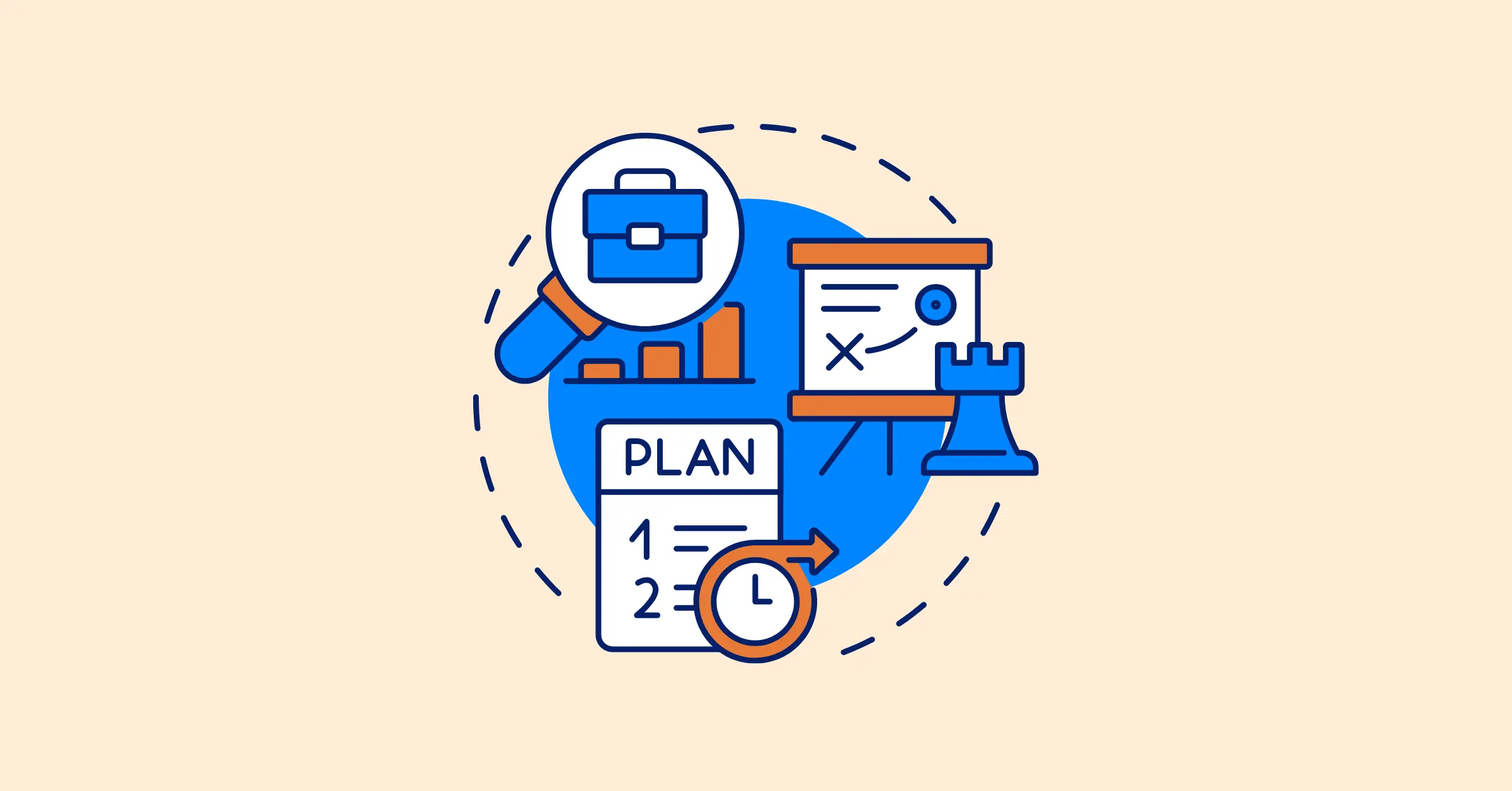Capacity Planning: Key Terms and Steps You Can Apply Right Away
Discover what capacity planning is and learn actionable tips and strategies to optimize resources and balance workloads.
What is capacity planning? Capacity planning is a crucial part of resource management, yet it’s often misunderstood. At its heart, it’s about making sure your business has the right people, tools, and time to meet demand—without overloading your team or wasting resources.
In this guide, we’ll break down what capacity planning really means, why it matters, and share practical steps you can use to make the process easier and more effective.
Key Takeaways:
- Understand what capacity planning is and why it matters.
- Learn about different types of capacity planning and how they apply across industries.
- Discover key terms and concepts of capacity planning.
- Explore actionable tips and strategies to simplify the capacity planning process.
Introduction to Capacity Planning
1. What is Capacity Planning?
At its core, capacity planning is the process of figuring out whether you have enough resources—like people, time, tools, or budget—to meet current and future demands. In simple terms, it helps answer the question: “Do we have the right capacity to get the work done without overloading anyone or falling short?”
It’s about balancing supply (your available resources) with demand (the work that needs to be done). When done well, capacity planning prevents burnout, reduces wasted effort, and ensures projects stay on track.
2. Types of Capacity Planning
Capacity planning isn’t a one-size-fits-all concept. Depending on your business model, you may need to focus on one or more of the following types:
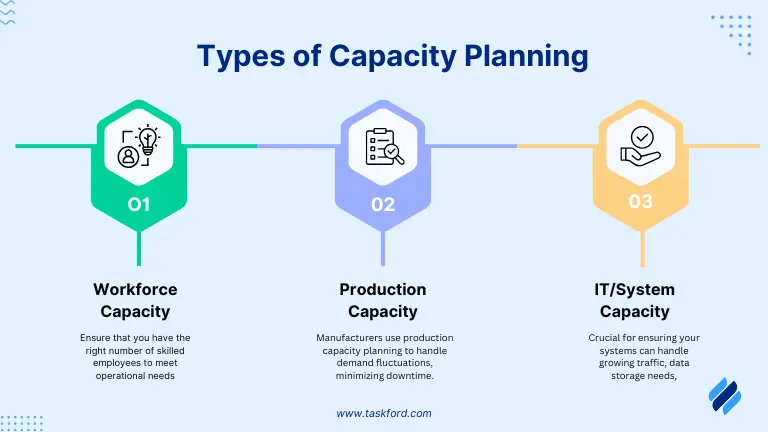
- Workforce Capacity: This involves ensuring that you have the right number of skilled employees to meet operational needs. For instance, a retail business might require additional staff during the holiday season.
- Production Capacity: Production capacity planning is commonly used in manufacturing. It focuses on making sure factories and facilities can handle changes in demand without delays, bottlenecks, or wasted resources.
- IT/System Capacity: IT capacity planning makes sure your systems, servers, and applications can handle growth—such as higher website traffic, larger data storage, or more users. Without it, businesses risk downtime, slow performance, and poor customer experiences.
- Resource Capacity: Resource capacity planning looks at shared assets like tools, vehicles, meeting rooms, or software licenses. The goal is to prevent conflicts and shortages when multiple teams need the same resources.
- Product/Service Capacity: This type ensures your business can produce or deliver enough products or services to meet customer demand, especially during peak times like product launches or seasonal sales.
- Equipment/Tool Capacity: Checks whether the right machines, tools, or technology are available and in good working order to support ongoing operations and projects.
There are six main types of capacity planning—workforce, production, IT, resource, product/service, and equipment—that help businesses balance resources with demand.
3. Why Capacity Planning Matters In Various Industries?
Capacity planning isn’t a one-size-fits-all process—it plays a unique role depending on the industry. Here’s how it makes an impact across different sectors:
- Manufacturing: Helps factories meet production targets without bottlenecks, wasted materials, or costly downtime. It ensures equipment, staff, and supply chains are aligned with demand.
- Healthcare: Besides that, it ensures hospitals and clinics have enough staff, beds, and medical equipment to serve patients, especially during seasonal peaks or emergencies.
- IT and Cloud Services: Prevents system overloads by making sure servers, networks, and applications can handle growing user traffic and data needs. This reduces downtime and improves user experience.
- Retail & E-commerce: It helps stores and online businesses prepare for high-demand periods like holiday sales. Proper planning ensures enough stock, staff, and systems to handle the surge.
- Professional Services: Also, capacity planning supports agencies, consultancies, or project-based businesses in balancing workloads, staffing, and timelines so projects are delivered on time without overworking teams.
- Hospitality & Travel: Ensures hotels, airlines, and travel providers have the staff and resources to meet customer needs during busy seasons while maintaining service quality.
Key Concepts of Capacity Planning
Capacity planning can feel overwhelming, but understanding its key concepts simplifies the process and ensures effective resource planning. Let’s dive deeper into the foundational principles that make capacity planning a valuable practice for any organization.
1. Resource Utilization
Resource Utilization measures how efficiently an organization uses its available resources. The goal is to find the right balance:
- Overutilization can lead to employee burnout, mistakes, and inefficiency.
- Underutilization means wasted capacity and higher costs.
Measuring utilization helps businesses understand whether workloads are realistic and where adjustments are needed.
2. Balancing Cost and Efficiency
One of the biggest challenges in capacity planning is finding the right balance between keeping costs under control and maintaining efficiency.
- If you focus only on efficiency (maximizing output), you may end up overspending on extra staff, equipment, or technology you don’t always need.
- If you focus only on cutting costs, you risk underutilizing resources, missing deadlines, or overloading your team—which often leads to mistakes and lower quality.
The key is to strike a middle ground:
- Use data and forecasting to predict demand more accurately.
- Maintain a buffer capacity to handle unexpected spikes without over-investing.
- Regularly review utilization rates to ensure resources are neither wasted nor overstretched.
When done well, capacity planning helps organizations stay lean on costs while still being agile and efficient enough to meet demand.
3. Forecasting Demand
Forecasting demand is one of the most important parts of capacity planning. It’s about predicting the amount of work, products, or services your organization will need to deliver in the future. Accurate forecasts allow businesses to prepare resources ahead of time instead of reacting at the last minute.
Why it matters:
- Prevents overstaffing or understaffing.
- Helps avoid wasted resources and costs.
- Improves customer satisfaction by ensuring you can meet demand consistently.
Ways to forecast demand:
- Historical Data: Looking at past performance to spot trends (e.g., retail sales always spike during the holidays).
- Market Trends: Considering industry changes, new product launches, or seasonal shifts.
- Predictive Tools: Using software and analytics to create data-driven forecasts.
4. Workload Forecasting
Workload forecasting is the process of predicting how much work your team will need to handle in the future. It helps distribute tasks fairly, prevent burnout, and keep projects on schedule.
How it works:
- Look at past project data.
- Estimate hours or resources for upcoming tasks.
- Factor in variables like seasonal peaks or team availability.
- Adjust as priorities change.
Example: A software team may forecast 300 hours for coding, 150 for testing, and 50 for deployment, helping them assign the right people and avoid last-minute crunch.
5. Billable Hour Tracking
Tracking Billable hours is the process of recording the time employees spend on client-related work that can be invoiced. It’s a key practice for service-based businesses like consulting, legal, and creative agencies.
6. Human Resource Allocation
Human resources are one of the most vital and variable components of capacity planning. This is the process of assigning the right people to the right tasks at the right time. Since employees are one of the most valuable and flexible resources in any organization, proper allocation is crucial to both productivity and morale.
In summary: These concepts—utilization, cost-efficiency balance, forecasting, workload planning, billable tracking, and human resource allocation—work together to ensure resources are used effectively, costs are managed, and businesses remain agile in meeting changing demands.
Capacity Planning Strategies
Effective capacity planning requires a well-thought-out strategy to ensure your organization can meet demand efficiently and cost-effectively. The three main strategies—lead capacity planning, lag strategy planning, and match strategy planning—each have unique advantages and are suited for different business needs. Let’s explore each in detail.
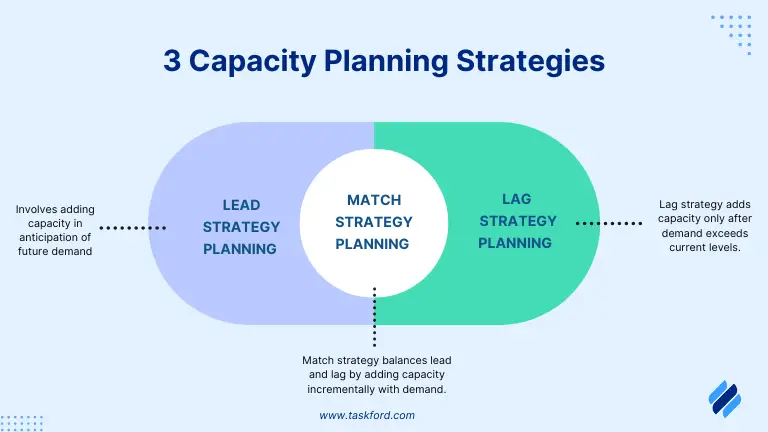
1. Lead Capacity Planning
Lead capacity planning involves adding capacity in anticipation of future demand. This proactive approach ensures that resources are available before they are needed, which helps avoid shortages or bottlenecks.
Advantages:
- Prevents customer dissatisfaction due to insufficient capacity.
- Enables businesses to meet sudden surges in demand without disruptions.
- Creates a competitive edge by ensuring readiness for market growth.
Challenges:
- Risk of overestimating demand, leading to underutilized resources and higher costs.
- Requires accurate forecasting and significant upfront investment.
Real-World Example:
Amazon uses a lead strategy before Prime Day and Black Friday, hiring extra staff, boosting delivery capacity, and expanding AWS servers in advance to handle huge demand spikes smoothly.
Lag Strategy Planning
Lag strategy planning takes a reactive approach, where additional capacity is only added after demand has exceeded current capacity. This strategy prioritizes cost efficiency over readiness.
Advantages:
- Minimizes the risk of overinvesting in unused capacity.
- Reduces operational costs, as resources are added only when needed.
- Useful in stable or predictable markets with consistent demand patterns.
Challenges:
- Risk of customer dissatisfaction due to delayed response to demand spikes.
- This may result in lost revenue opportunities if resources are not scaled up quickly enough.
Real-World Example:
Airlines often use a lag strategy by waiting to add new routes or flights until passenger demand is consistently high. This avoids the cost of running half-empty planes.
Match Strategy Planning
Match strategy planning strikes a balance between the lead and lag strategies. It involves incrementally adding capacity to meet demand as it grows while maintaining a close alignment with real-time needs.
Advantages:
- Reduces the risk of underutilization or overloading resources.
- Offers flexibility and scalability, adapting to changes in demand without significant delays.
- Balances cost-efficiency with customer satisfaction.
Challenges:
- Requires consistent monitoring and data analysis to adjust capacity effectively.
- May involve higher operational complexity due to frequent adjustments.
Real-World Example:
An IT company upgrades its cloud servers gradually as user traffic grows, adding capacity in small steps instead of all at once. This balances cost control with flexibility.
How to Choose the Right Strategy
The choice of a capacity planning strategy depends on market dynamics, business goals, and risk tolerance. Businesses focused on customer satisfaction and preparedness may favor a Lead Strategy, while those prioritizing cost control often adopt a Lag Strategy. A Match Strategy works best for organizations seeking flexibility and balance by scaling gradually with demand.
In reality, many companies combine these approaches—for example, using a lead strategy for critical operations while applying lag or match strategies to less critical areas.
By understanding these three strategies and tailoring them to your organization’s needs, you can create a capacity planning framework that supports growth, optimizes costs, and ensures customer satisfaction.
Actionable Tips for Simplifying Capacity Planning
Capacity planning is essential for ensuring that your team has the right resources at the right time to meet project demands. When done effectively, it helps balance workloads, avoid burnout, and optimize efficiency.
Let’s break down three practical capacity planning tips that will empower your team to work smarter, not harder.
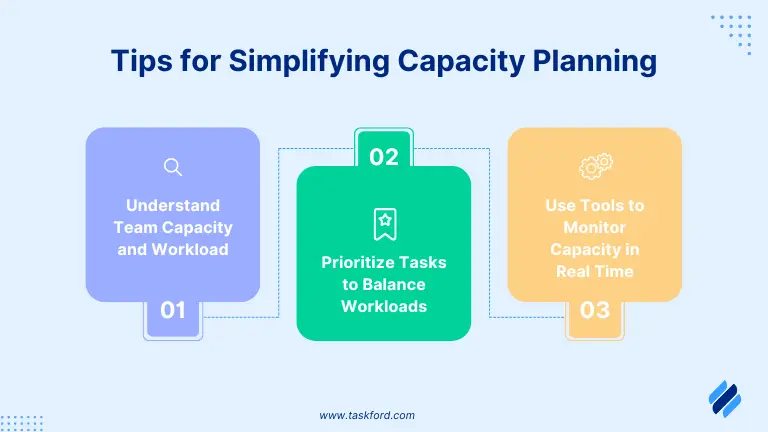
Tip #1: Understand Team Capacity and Workload
Before starting any project, it’s important to know how much work your team can really take on. Capacity means the total time your team has available, while workload is the actual work assigned. Balancing these two helps avoid burnout and missed deadlines.
How to Get Started:
- Check Team Availability - Figure out how many hours each person can work in a week. Remember to include time for meetings, breaks, and other small tasks.
- Track the Work - Use a simple tool or tracker to log tasks and see how long they actually take. This shows if your team is doing too much or not enough.
- Adjust for Different Tasks - Some tasks take more focus or special skills than others. Don’t count all hours as equal—make adjustments where needed.
Pro Tip:
Update your team’s capacity often. Things like vacations, sick days, or new projects can quickly change how much time people have.
Why it matters:
When you know your team’s real capacity, you can plan projects better, set realistic deadlines, and keep workloads balanced. This leads to less stress and better results.
Tip #2: Prioritize Tasks to Balance Workloads
Capacity planning isn’t just about knowing how much your team can handle—it’s also about assigning work efficiently. Without clear priorities, even a team with ample capacity can become overwhelmed.
How to Prioritize:
- Rank by Importance - Use methods like the Eisenhower Matrix to identify urgent and high-priority tasks.
- Distribute Work Evenly - Assign tasks based on team members’ availability and skill sets to avoid overloading specific individuals.
- Adjust as Needed - If priorities shift during a project, reallocate tasks to ensure deadlines are met without overburdening the team.
Pro Tip:
Involve your team in setting priorities. This collaboration ensures buy-in and helps identify potential bottlenecks early.
Why it matters:
Prioritizing tasks helps prevent overload, reduces wasted effort, and keeps the team focused on delivering the most valuable results.
Tip #3: Use Tools to Monitor Capacity in Real Time
Spreadsheets can work for small teams, but as projects grow, tracking capacity manually becomes difficult. Using the right tools helps you see workloads, availability, and progress instantly.
Recommended Tools:
- Project management software: It helps teams plan tasks, assign work, and track progress in one place. These tools make it easier to stay organized, spot bottlenecks, and keep projects on schedule.
- Resource management features: Use tools with built-in capacity planning to visualize team availability and optimize resource allocation. They make it easier to assign tasks fairly, avoid overbooking, and ensure the right people are working on the right projects.
- Time tracking tools: Track how much time team members spend on tasks and projects. Comparing planned hours with actual time worked makes billing more accurate and improves future planning.
Example:
TaskFord is a comprehensive project management and resource planning platform with built-in time tracking. It allows teams to plan tasks, balance workloads, and monitor progress in real time—making it easy to see who’s available, who’s overloaded, and how projects are moving forward.
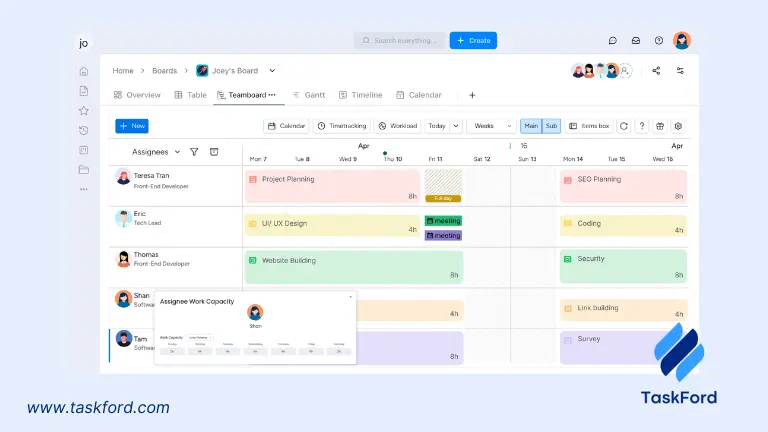
Final Thoughts
Understanding what is capacity planning and implementing the right strategies ensures your organization operates efficiently, meets demand, and controls costs. By focusing on key concepts, tailoring your approach, and leveraging modern tools, you can simplify capacity planning and empower your team to thrive.
Start small, focus on critical areas, and refine your approach as you go. With these actionable tips and strategies, capacity planning becomes not just manageable but a strategic advantage.
Making work simpler,
smarter, and more connected
Join our waitlist and be notified first.

Related Blog
Subscribe for Expert Tips
Unlock expert insights and stay ahead with TaskFord. Sign up now to receive valuable tips, strategies, and updates directly in your inbox.





